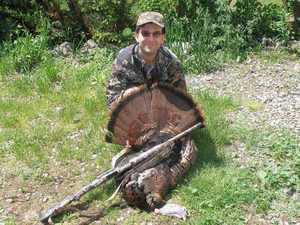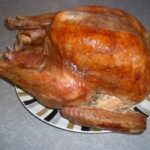As all you hunters out there know, big game hunting season has been over in New York State for a few months now. But if you still have had hunting on the brain since deer season has ended, have no fret, Spring Turkey Hunting Season in upstate New York is only 35 days away. Spring Turkey hunting season begins May 1st and ends May 31st and you can hunt a half hour before sunrise until noon during which time you can only take two bearded birds, one per day.
There is nothing like the thrill of sitting perfectly still in the pines in upstate New York on a crisp spring morning, in full camouflage, calling in a big boss Tom, watching him strut around toward you and coming just within shotgun or bow range and then slapping that shotgun trigger or releasing an arrow and watching your trophy go down.
Spring Turkey hunting encompasses the challenges of calling in a Tom using a mouth call, slate or box call, and all the while sitting perfectly still behind a natural or artificial blind. Patience is the key and knowing when to call.
There are so many different types of mouth calls, slate calls, box calls and even push button calls that a first time turkey hunter can get easily confused on what to use and how to use them. Despite what many different people think, I only use a slate call. I’ve had great success with this type of call. A slate call is a circular piece of slate embedded into a circular piece of metal with holes in the bottom. It’s like taking a rounded dowel and literally scratching it against a blackboard. As you hold the call in the palm of your hand, using a wooden rounded dowel rub the tip of the dowel onto the slate. Applying just the right amount of pressure and depending on how you hold the dowel you can make different turkey sounds i.e. yelps, clucks, and purrs. It has been shown through the years that the sounds that are reproduced actually attract Toms during spring mating season.
Getting your first Tom can be even more of thrill if you have not had success before. I remember my first Tom as if it was yesterday. I was sitting approximately 10 feet into the woods with my back against a tree, a hill just behind me and a clearing just in front of me with a narrow field of fire. I was sitting there from just before sun up, waiting, calling and hearing the gobblers answering my calls. But I saw no movement whatsoever. I was getting tired and my patience was wearing thin. I had bugs crawling on me and gnats flying around my head. But it was about 11:30AM when I called again using a slate caller. Suddenly I heard a thunderous gobble approximately 50 yards in a clearing to my left. I called again, and the thunderous gobble was louder and closer this time. A few minutes later I saw the strutting tail through the low lying branches of brush just off to my left approximately 40 yards watching Tom’s tail passing along the tree line. I had my Mossberg 535 pump action shotgun resting on my knee and aimed toward the narrow field of fire directly in front of me. Just then Tom decided to take a sharp right about 35 yards to my left and started to walk up toward the hill. He was so close I could have thrown a rock and would have hit him.
He proceeded up the hill and started to go behind me way outside of my field of fire. I slowly turned toward my left all the while watching Tom continue to move away from me. Suddenly Tom shrunk down into the leaves just behind me to my left – he must have seen or heard movement. As he lifted his head up and proceeded to continue his strut, I put the fiber optic sights on his head, waited for a narrow opening between trees, slapped the trigger and KA-BOOM!!! Tom was down. What a thrill! I will never forget that day. I was the only one of my buddies to get a Tom that season.
After recovering you trophy and tagging it properly, bragging to your friends about the size of the Tom’s beard (a clump of feathers that stick out from the chest of the Tom), the length of its spurs, and the span of its tail, and taking several pictures, you need to know how to dress it. But if you want to mount the Tom’s tail you will need to remove the tail carefully at its base and put it aside. If you have never mounted a Tom’s tail, look for my next article on mounting the tail yourself.
The easiest way to dress a turkey is to have hot boiling water handy, a 5 gallon bucket, and a sharp knife. The first thing that you need to do is to remove the feathers. This is best done using two people. While one person is holding the turkey head down in the 5 gallon bucket, the other person pours the boiling water over the body of the turkey. This softens the feathers and makes it easier to remove them.
Once the feathers are all removed, then you need to remove its head, and feet. You can do this using a sharp knife or a small saw. The next thing to do is to lay Tom on his back on a clean flat surface so you can start cutting and removing the internal organs. Lift the skin up with your fingertips slide the point of the knife into the chest cavity just below the breast bone and start cutting down ward being careful not to pierce any of the organs. Doing so can spoil the meat. Pull the skin apart and start removing the internal organs making sure not to puncture or tear them. After you remove all the organs, rinse the inside cavity with warm water to clean out any dried blood. It is best to get a large bowl filled with warm water and salt and place the bird inside for several hours so that any remaining feathers and dried blood can soak away. Now you can dry the bird and either store it in the freezer or prepare it for cooking.
There is nothing like the taste of a fresh wild turkey. Once you have eaten wild turkey, trust me, you will never go back to eating a store bought “butterball.






